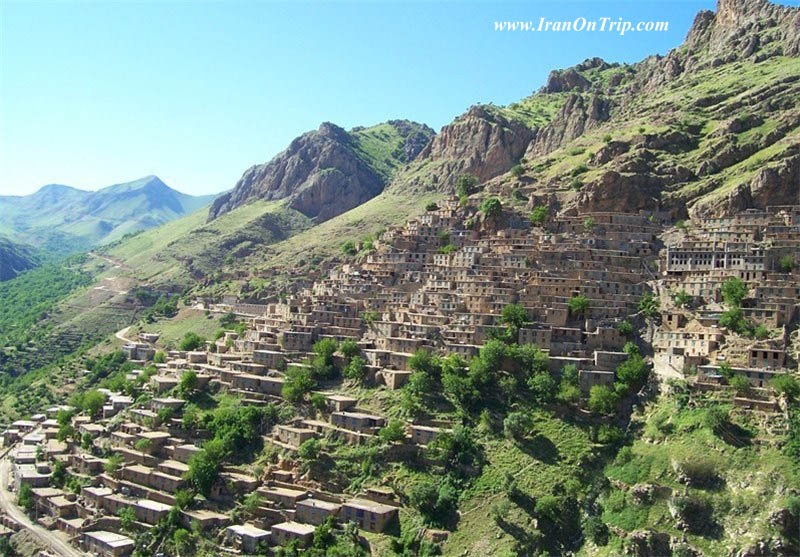Oramanat Takht Village-Kurdistan

Uraman or Huraman, as it is called in the Kurdish language, is a vast area covering the entire south of Kurdistan Province.
It has a very fine and pleasant weather. The area, due its mountainous terrain, is rich in tourist attractions and natural fascinations. Some of these attractions include "Darband Dezli" region with its highlands and green slopes, and the "Abshar Maloor" waterfall which obtains its water from the snow melting on high mountains. Terraced farms and stone architecture of terraced villages, where the roofs of one row of houses happens to be the courtyards of another row of houses situated on a higher level, add to the beauty of the region. Uraman village is located in an east-west valley on a steep slope overlooking the northern front of the Takht Mountains 75 km south of the city of Marivan. Since the village had been the center of the local rulers, it is called Uraman Takht, takht meaning throne in Persian. The climate of this region in spring and summer is very pleasant and it is very cold in winter. The Uraman Takht Village is one of the attractive rural areas of Kurdestan which besides its panoramic views has valuable tourism capacities because of the annual performance of an ancient and wonderful ceremony of Peer Shahriar.
The inhabitant of this territory and their language is known as Hevarami. The Urami dialect of Kurdish is spoken here. Ancient fire temples and remnants of this region indicate that the inhabitants were Zoroastrians before embracing the truth of Islam. The Sirvan River flows from the deep valleys of this region and meanders into neighbouring Iraq. The border areas of the Sirvan River are called Ravar. Here the lands are covered with walnut, pomegranate, fig and mulberry trees. In spite of rugged geographical climatic conditions the inhabitants abide by their traditions. The tomb of Peer Shahriar Urami, writer of the book Acquaintance of the Peer, is revered site for the local people. The Peer Shahriar commemoration is held twice a year. The first one falls on 15th of Ordibehesht or the second month of the Iranian calendar roughly corresponding with May and the next ceremony falls on 10th of Bahman the second month of the Iranian calendar roughly corresponding with February. The spring ceremony is called Koohsari which is accompanied with the playing of instruments like Daf and delivering speeches on Pir Shahriar's personality. The winter ceremony is called "Aroosi Pir Shahriar" and celebrated for two weeks.
Of the other religious sites, mention could be made of the Oihang and Abdollahi mosques, and the tomb of "Loskeh Hijij" which is highly respected by the people of the region. The economy of the Uraman Takht village is based on agriculture, horticulture, and cattle-breeding. Wheat, barley and lentil are the most important crops and there are large gardens of pear, walnut, mountain fig and pomegranate. Medicinal plants like hollyhock, borage, yarrow, goat's thorn, licorice, etc. occur a lot on the vast expanses of this area, too.
Uraman Takht manifests genuine Kurdish art and civilization. This is mostly seen in its literature and music. The clothes of people here, like in many other rural areas, have beautiful designs and colours.
Now we'll take you to one of the most beautiful and biggest water caves of Asia namely Qoori Qale', which is located on the western slope of Mount Shahoo in the vicinity of the city of Paveh.
Among the oak forests of Uraman and Paveh is the Qoori Qaleh Cave which is considered the largest water cave in Asia. This cave begins in the Qoori Qaleh Village and according to people continues well into mountains on the other side of the Iranian border in Iraq. In 1989, a group of mountaineers succeeded in discovering the internal portion of the cave and its various halls. This group in addition to gaining access to the depth of the cave discovered about 12 dark and meandering passages and mapped them. In this cave a rare species of bats has been seen. A variation of colours and oblique pillars and waterfalls are unique characteristics of the Qoori Qaleh Cave. The Qoori Qaleh village has pleasant weather with a spring of limpid water gushes from the bowels of the earth, and serving as a source of water for the local farmers. The valley where the cave is located is very beautiful and has numerous springs and spectacular sceneries. The temperature inside the cave is between 7 to 11 degrees Celsius and is almost constant throughout the year. The crystal clear waters at the entrance of the cave have an average depth of 1.5 to 2 meters. To date some 13 km of the winding passages of the cave have been discovered but nobody has found its end yet. The halls of the cave are very colorful and decorated with stalagmites and stalactites. Each hall has a name according to its natural attractions. For instance, "Talar-e Aroos" or Bride's Hall and "Talar-e-Boloor" or Crystal Hall have translucent stalactites of different shapes. Inside Talar Boloor, with its 14 meter deep pond, there are transparent stalactites reflecting the light in several colours. It is worthy to know that Qoori Qaleh cave has umbrella-like configurations which have gained worldwide fame, especially in the Talar-e Aroos that has inverted umbrellas.
Each of the halls of the Qoori Qaleh Cave reveals mysteries of the earth's geological history and the marvels of creation. Numerous historical findings such as pottery, coins and skulls inside the cave indicate that it was the dwelling or the burial site of a pre-historic people, perhaps as far back as 8000 years ago. If geologists are to be believed the Qoori Qaleh Cave was formed much later than other Iranian caves such as Ali Sadr in Hamedan, Kataleh Khor in Zanjan, and Kolahrood in Isfahan Province. Qoori Qaleh is registered as a natural heritage of Iran.
.....
.....
.....

.jpg)



























